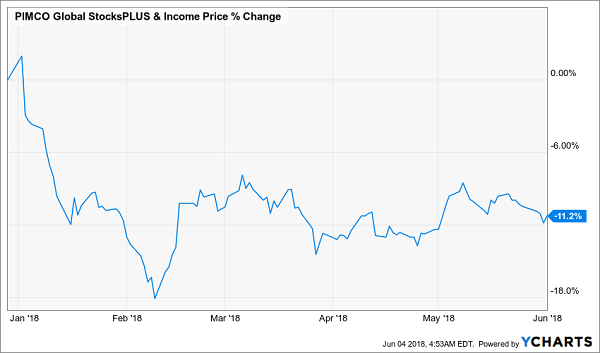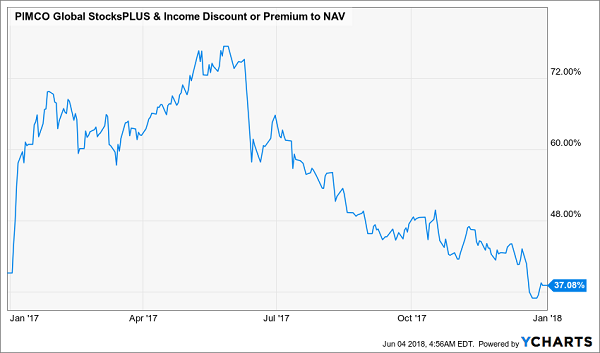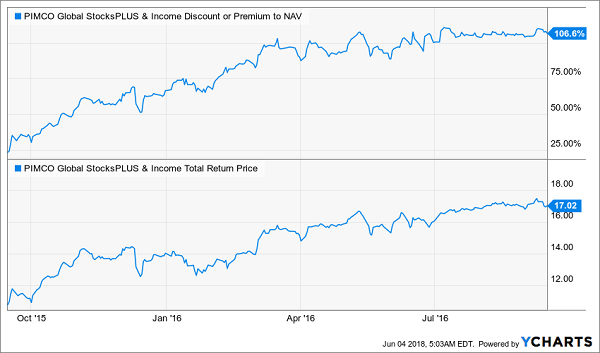Today I’m doing something unusual: I’m changing my call on a popular closed-end fund (CEF).
Why?
Because this fund has gone on sale, and it’s just too good of a deal to overlook. If history is any guide—and with this fund it almost always is—it’s in for some nice upside very soon. In the meantime, buyers will grab a hefty and safe 10.9% cash dividend!
So if you dropped, say, $100k into this fund tomorrow, you’d get nearly 11% of your investment back—in cash—just one year from now (and I should also mention that it pays dividends monthly, too).
I’m talking about the PIMCO Global StocksPLUS & Income Fund (PGP). It’s attractive now after doing this in 2018:
A Bad Fall

If you’re a regular reader of my articles on Contrarian Outlook, you may be surprised to hear this.
In early 2018, I warned that PGP was a fund to avoid following a 17% dividend cut. And I’ve beaten up on PGP many times before. Nearly a year ago, I urged readers to run away after the fund had risen 25% in the first half of 2017.
So you can say that I’ve been a PGP critic for a long time.
The reason is simple: a lot of investors were getting enticed by PGP’s massive payouts, so the fund was trading at a huge premium to net asset value (NAV, or the market price of the fund’s underlying assets).
But here’s the key thing: after the dividend cut, PGP’s dividend has become extremely sustainable relative to how it’s been in the last few years—in fact, PGP’s dividend is covered enough that we aren’t likely to see another cut for a long time.
However, the market isn’t pricing PGP for that—in fact, now, it’s being priced for a cut to come soon, although that’s unlikely. We see that in its lower premium. At their height, PGP shares were selling for a 75% premium to NAV, meaning for every $1 in assets, you had to shell out $1.75 just to get in. And then that premium collapsed:
Falling Further and Further

That’s why PGP is attractive now. At 27.9%, PGP’s premium is actually less than half of its 10-year average premium of 53.3%. And while paying a premium is often a bad idea, paying it with PGP can often work out well for you, in large part because PGP always trades at a premium thanks to the fund’s ability to cover its massive dividend and grow its NAV, as it has been doing in 2018.
But the real story here is how you can capture PGP at a lower premium compared to its historic average, then sell when it goes over that average (and get PGP’s 10.9% dividend while you wait). That’s easy to do—as I’ll show you now.
Timing Unusual Fund Bargains
Let’s look at history to see how you would have made out by “working” PGP’s premium in the past.
The last time PGP’s premium fell below 30% was brief, in mid-2015. If you remember, that was when the market was panicking about a looming rise in interest rates (sound familiar)? And when investors ran away from PGP because of their rate-hike fears, they gave up these returns:
PGP’s Premium Rises—and so Do Returns

Within a year, the fund’s premium had risen to 106.6% (yes—people were paying over $2 for a buck worth of PGP’s assets!), and investors had gained a 58.2% total return.
Investors with bad timing, however, got the exact opposite. Anyone who bought PGP when its premium reached its height in September 2016 got burned over the next year:
Buying High Means Losing Big

Over the year following PGP’s price apex, the fund’s premium fell 45.3%, and investors lost 10.4%.
The takeaway: you can make a lot of money in CEFs by following the relationship between their market price and NAV and investing accordingly; you can also lose a lot of money if you don’t. PGP is one of those classic funds that’s great to avoid when its premium gets ridiculously high but is also great to buy when the market is overly cautious—like in mid-2015 or right now.
Proven Profit Signal Reveals 4 More Must-Buy CEFs
Most of the so-called experts on Wall Street or in the financial media will tell you that any dividend over, say, 4% is dangerous and headed for a cut.
So instead, they tell us, we have to settle for the pathetic 1.8% the average S&P 500 stock pays.
They’re dead wrong—because very few of these “pros” have even bothered to look at the eye-popping yields CEFs deliver all the time.
Take the 17 funds in my CEF Insider service’s portfolio. Right now, subscribers who hold these 17 stout income plays are pocketing a safe 7.4% average CASH dividend year in and year out.
That works out to $7,400 in cash on every $100,000 invested, 4 TIMES more than the misers of the S&P 500 pay! And this unique portfolio is stuffed with bargains spring-loaded for quick 20%+ upside too.
This is a far better strategy than staking huge sums on one fund—PGP in this case—because my CEF Insider portfolio spreads your money across almost every sector you can name: US stocks, high-yield REITs, floating-rate bonds, foreign stocks and more.
The bottom line? You’re getting safety, incredible income and quick double-digit upside here.
And here’s the best part—right now, I’m letting a select few investors “kick the tires” on these 17 retirement lifesavers through a no-risk 60-day trial you can jump on right here.
That’s not all. Along with immediate access to this carefully crafted income portfolio, I’ll GIVE you my latest Special Report FREE!
This exclusive guide reveals the names, tickers, buy-under prices and more on my 4 very best CEFs to buy now. Grab these 4 cash machines now and you’ll grab a 7.6% average income stream and position yourself for 20%+ upside in the next 12 months!

Recent Comments